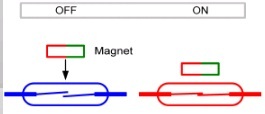COMPONENTES ELÉCTRICOS Y ELECTRÓNICOS
Home Sensores PIC Sensores-Conmutadores Reed Preguntas frecuentes sobre Reed Switches
Preguntas frecuentes sobre Reed Switches

How does a Reed Switch work?
A Reed Switch consists of a pair of ferromagnetic reeds, overlapping at their free ends (contact area) at a very small distance and hermetically sealed in a glass tube. The contact area is plated with contact material such as Ruthenium or Rhodium. In presence of a magnetic field the reeds become magnetized the opposite polarity, thus attracting each other and closing contact.

What are the advantages of Reed Switches?
Non-touch switching
Highly economic
No supply current required
No minimum switching current necessary (except e.g. for Tungsten contact material)
High reliable switching
Low contact resistance (0.07 to 0.2 Ohms initial)
Even suitable for ex-protected and harsh environment, since contacts are hermetically sealed
Billions of operations at signal loads through lifetime
Which are the different Reed Switch types?
Generally there are
Form A, also known as SPST (Single Pole Single Throw - Normally Open)
Form B, also known as SPST-NC (Single Pole Single Throw - Normally Closed)
Form C, or change over contact is also abbreviated SPDT (Single Pole Double Throw)
Form E is a bi-stable contact. Switching state of this also called Latching-Type remains unchanged (even in absence of magnetic field) until a magnetic field of opposite polarity is present
Furthermore there is a number of special Reed Switches, i.e. for High Voltage applications or ultra miniature types for implants etc.
What does "AT" stand for?
AT means Ampere-Turns and is a standard unit categorizing the magnetic sensitivity of Reed Switches. The AT value is measured by centering the Reed Switch in a standard coil, to which an increasing current is applied. At a certain current (Amps) the Reed Switch closes by means of the magnetic field generated by the coil. This is the Operate (or Pull In) value, calculated as Amps x number of coil turns = AT. Reducing the current passing through the coil until the switch reopens, the Release (or Drop Out) value can be obtained.
What makes Reed Switches differ in terms of AT values?
High AT value = low sensitivity. Thus a strong magnetic field is necessary to operate the Reed Switch (respectively the switching distance between magnet and switch will be smaller)
Low AT value = high sensitivity, allowing to operate the switch even with a weaker magnetic field (respectively the switching distance between magnet and switch can be increased)
What is Hysteresis?
Hysteresis is the difference between Operate AT and Release AT of a Reed Switch. I.e. a Reed Switch contact closes approaching a magnet to 10 mm distance. However the switch will re-open at a magnet distance of 12 mm. Some special Reed Switches like our PMC-1406 feature a very low hysteresis ("close differential" types).
What lifetime do Reed Switches have?
Lifetime depends on load conditions. Switching signal loads only, hundreds of millions up to some billions of switching cycles can be achieved. Higher loads (e.g. mains applications or high currents) may provide some 10,000 up to some millions of switching cycles. Usually the Reed Switch lifetime itself is much longer than the lifetime of the device incorporating the Reed Switch. As a general rule same contact protection as for common mechanical switches (varistors, diodes, RCs) should be provided for Reed Switches in order to not reduce life expectancy.
How can I maximize switching distance between Reed Switch and magnet?
Strong magnet
and/or
sensitive Reed Switch
and/or
actuation optimization (positioning of magnet and Reed Switch)
How to achieve highest switching accuracy
Magnetic field should be "spot focussed" towards the contact area of the Reed Switch. Providing single pole actuation, smallest possible switching difference is the result.
Lowest hysteresis of Reed Switch is recommended since difference in switching distance between ON and OFF is very small for this type
The less tolerances for the magnet and Reed Switch, the better
What is the difference between switching current and carry current?
Prior to conduct the maximum current allowed for the closed contact (carry current) the contacts need to join with enough force and area to finish closing process (while closing, switching current is the limit). That's why carry current normally exceeds switching current.
Solderability of Reed Switches
Reed Switches are solderable with any of common soldering technologies (wave, reflow, vapour phase, hand soldering).
Do you supply axially taped Reed Switches?
No. But as alternative we provide SMD Reed Switches.
Are your products lead free / complying with the RoHS directive?
Yes, most of our products are lead free and comply with the RoHS directive.








